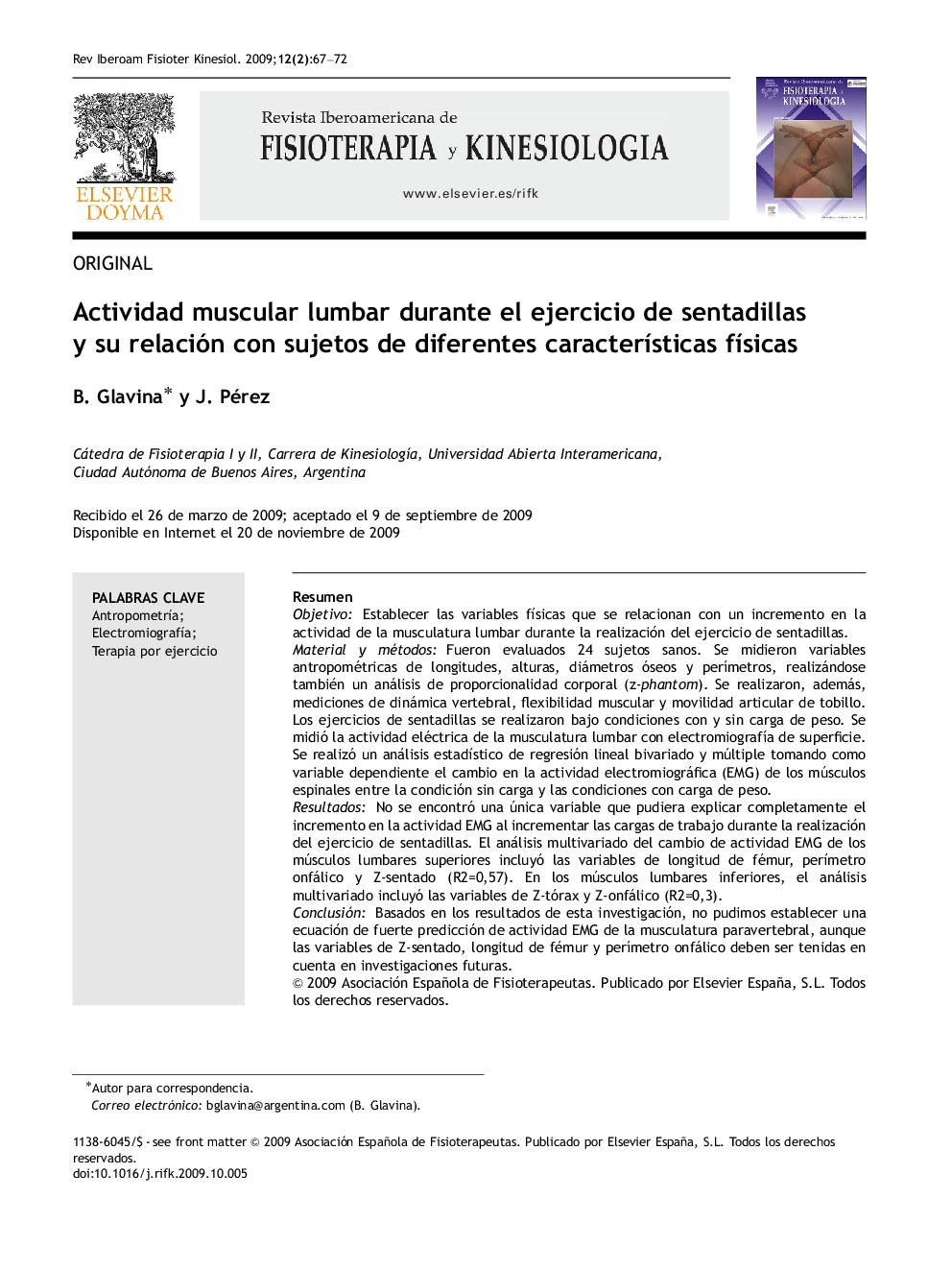| Article ID | Journal | Published Year | Pages | File Type |
|---|---|---|---|---|
| 2628042 | Revista Iberoamericana de Fisioterapia y Kinesiología | 2009 | 6 Pages |
ResumenObjetivoEstablecer las variables físicas que se relacionan con un incremento en la actividad de la musculatura lumbar durante la realización del ejercicio de sentadillas.Material y métodosFueron evaluados 24 sujetos sanos. Se midieron variables antropométricas de longitudes, alturas, diámetros óseos y perímetros, realizándose también un análisis de proporcionalidad corporal (z-phantom). Se realizaron, además, mediciones de dinámica vertebral, flexibilidad muscular y movilidad articular de tobillo. Los ejercicios de sentadillas se realizaron bajo condiciones con y sin carga de peso. Se midió la actividad eléctrica de la musculatura lumbar con electromiografía de superficie. Se realizó un análisis estadístico de regresión lineal bivariado y múltiple tomando como variable dependiente el cambio en la actividad electromiográfica (EMG) de los músculos espinales entre la condición sin carga y las condiciones con carga de peso.ResultadosNo se encontró una única variable que pudiera explicar completamente el incremento en la actividad EMG al incrementar las cargas de trabajo durante la realización del ejercicio de sentadillas. El análisis multivariado del cambio de actividad EMG de los músculos lumbares superiores incluyó las variables de longitud de fémur, perímetro onfálico y Z-sentado (R2=0,57). En los músculos lumbares inferiores, el análisis multivariado incluyó las variables de Z-tórax y Z-onfálico (R2=0,3).ConclusiónBasados en los resultados de esta investigación, no pudimos establecer una ecuación de fuerte predicción de actividad EMG de la musculatura paravertebral, aunque las variables de Z-sentado, longitud de fémur y perímetro onfálico deben ser tenidas en cuenta en investigaciones futuras.
ObjectiveTo identify the relationship between physical variables and the increase of the activity of the lumbar muscles during the performance of squat exercises.Materials and methodsTwenty-four normal subjects were evaluated. Anthropometric heights, lengths, breadths and girths were measured and an analysis of body proportionality of these variables was made with the Z-phantom model. Measurements were also obtained of back kinematics, muscle flexibility and ankle motion. The squat exercises were performed with and without weight load conditions. Electrical activity of lumbar extensors muscles was measured with superficial electromyography. A statistical analysis was performed by bivariate and multiple linear regression, using the change in the electromyographic activity of the spinal muscles between the no load condition and the loaded weight as the dependent variable.ResultsDuring squat exercise, no single predictor adequately explained the change of electromyographic activity with load increment. The multiple regression analysis of the change in electromyographic activity of the upper lumbar extensor muscles included femur length, umbilicus girth and z-sitting height (R2=0.57). Z thorax and Z-umbilicus girth in the analysis of the lower back extensors (R2=0.3).ConclusionBased on the results of this research, we could not establish a prediction equation of strong electromyographic activity of the paravertebral muscles, although the Z set of variables, femur length and umbilicus perimeter should be considered in future research.
